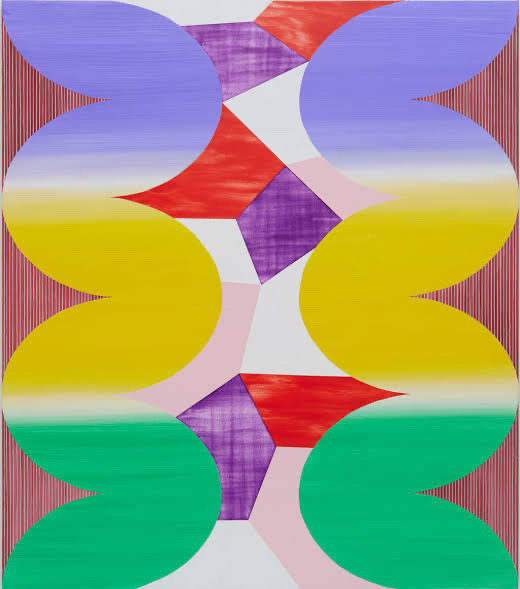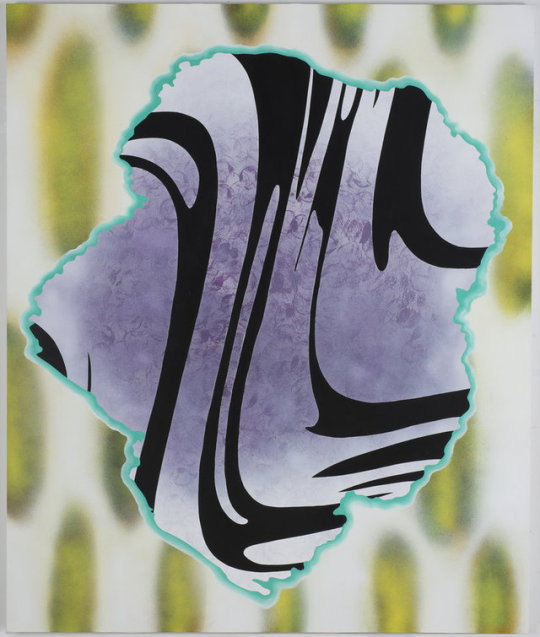#Shirley Kaneda
Photo

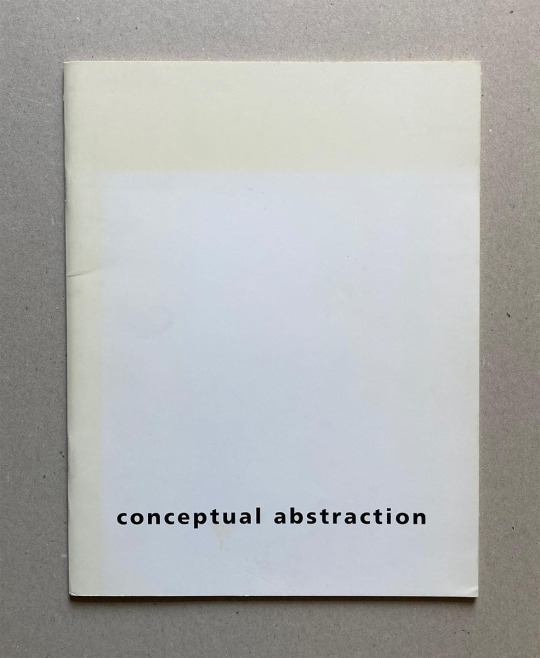
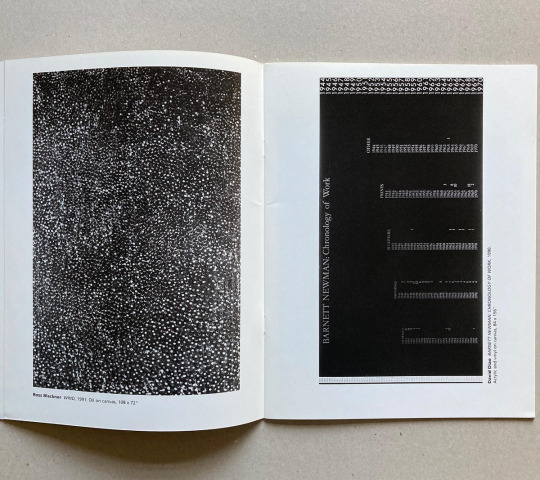
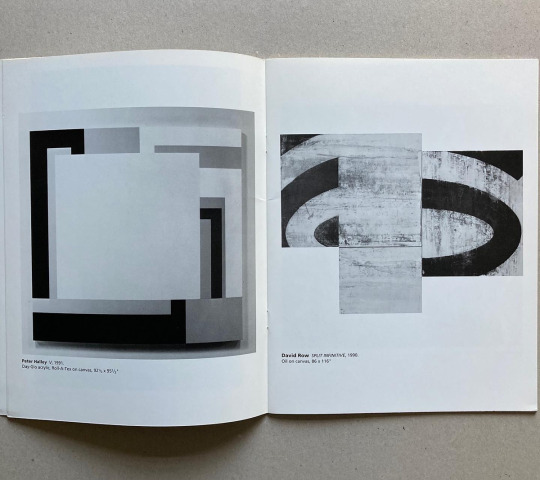


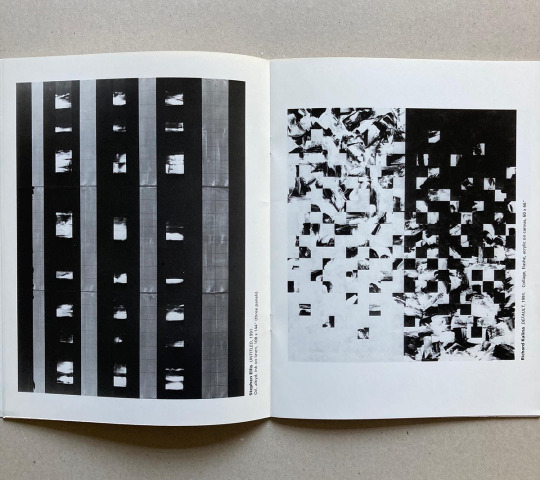
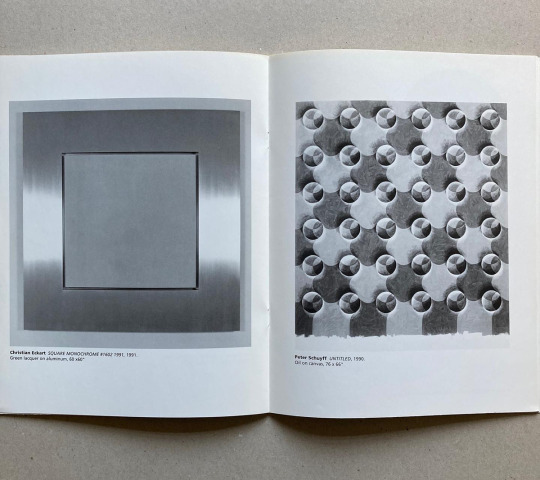
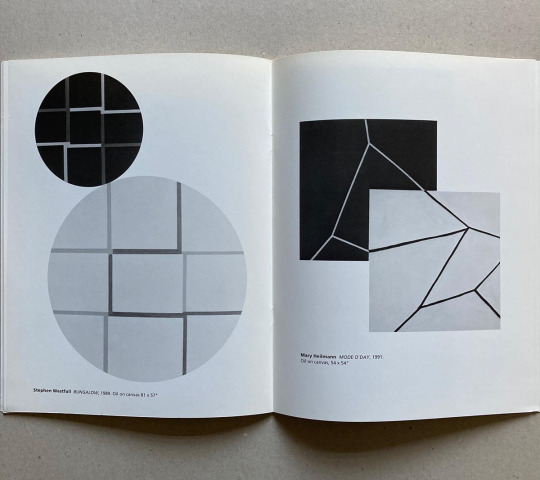

Conceptual Abstraction, Text by Carroll Janis, Sidney Janis Gallery, New York, NY, 1991 (pdf here) [Exhibition: November 7 – December 21, 1991] [Art Books & Ephemera]. Feat. David Diao, Lydia Dona, Christian Eckart, Stephen Ellis, Peter Halley, Mary Heilmann, Valerie Jaudon, Richard Kalina, Shirley Kaneda, Bill Komoski, Jonathan Lasker, Sherrie Levine, Tom Nozkowski, David Row, Peter Schuyff, Philip Taaffe, Stephen Westfall, John Zinsser
#graphic design#art#geometry#pattern#structure#exhibition#catalogue#catalog#cover#carroll janis#david diao#lydia dona#christian eckart#stephen ellis#peter halley#mary heilmann#valerie jaudon#richard kalina#shirley kaneda#bill komoski#jonathan lasker#sherrie levine#tom nozkowski#david row#peter schuyff#philip taaffe#stephen westfall#john zinsser#sidney janis gallery#1990s
32 notes
·
View notes
Text
The feminine in abstract painting
Shirley Kaneda, OCTOBER 21, 2017
https://www.womenandperformance.org/ampersand/shirley-kaneda-27-3
the notion of the feminine in abstract painting
to constitute a method of intervention, a way to insert into the discourse of identity and gender that had become significantly literary rather than aesthetic.
Since the world is predominantly based on a patriarchal society, the values that are attached to anything are usually masculine. - leading to exclusion of the feminine - the women making art that has just as much importance
“women make distinctive contributions to abstract painting with little recognition.“
concept of the feminine which was both a way to de-stabilize the universalist notion of “quality” and insert an alternative model based on rejected or supposedly inferior notions such as the decorative or the “de-skilled”

Shirley Jaffe, Adria’s Green (2014). Oil on canvas, 28 ¾ x 23 ½ inches (73×60 cm).
abstraction was no less capable of addressing concerns of gender and that it was imperative to do so in order for abstraction as a genre to evolve out of the hegemony of modernist criteria.
the feminine does not stand in opposition, nor is it “other.” The purpose of illuminating such a discourse was to argue that difference is not otherness
invalidating the diametric structure of the masculine/feminine split
femininity has/had? been owned and dictated by patriarchal society for a long time. Until fairly recently there was little autonomy to express beyond these hegemonic ideals
“By reasserting the feminine as a thing itself, I was attempting to rescue it and propose another set of terms for the construction of a subjecthood and female subjectivity specifically.”
masculine, which represents homogeneity, singularity, and equivalence
The point is to reconstruct a dynamic built on symbiotic asymmetry rather than the notions of competitive dialectic in which a set of contradictions vie for dominance.
As Walter Benjamin pointed out, the difference between Fascism and Socialism is that the Fascists aestheticised politics and the Socialists politicized aesthetics. are we now to speak of a feminine feminism or a feminist feminine? This is not a word play, but a play of concepts: one conceals and the other reveals, “between the idea of a political identity for feminism (what women require) and that of a feminine identity for women (what women are or should be)” (Rose 2011).
we must be conscious not only of what we say, but how we say it.
the feminine and the masculine are not gender bound
The problem that arises in most cases of appropriation of these readymade models is that they are used in non-reflexive modes. In these instances equality becomes reduced to a question of replacing a male figure being (beaten by a cop) with a brutalized female figure. Both are represented using the same vocabulary and the message is seemingly the same: stop brutality. There is no implicit or explicit alternative view proposed by the means of the experience in most cases and the signifier is once again charged with the value of the imagery, which is already recognizable as universal or masculine in its approach.
claim a position, not as other, but independent of the masculine world
cindy sherman - constructs a feminist identity in photography

Cindy Sherman, Untitled #92, 1981, chromogenic color print, 24 x 48 inches
But what is the relationship of painting to women?
Veteran feminist painters such as Judith Bernstein and Lee Lozano who painted male and female sexual organs to “own” and challenge the patriarchy were marginalized for many years. They are now being recognized and “discovered” by the market’s insatiability.

Judith Bernstein “Birth of the Universe #4.”

Lee Lozano. No title, 1962
Of late, there are women painters who deal directly with feminist issues through figurative imageries of oppression, dominance, abuse, or by appropriating known paintings by men to de-masculinize these visual imageries. Sue Williams has painted penises in the style of Jackson Pollock or Cecily Brown unabashedly paints pornographic scenes of coitus in her otherwise “abstract” paintings.

Sue Williams, We’ve Got a lot of Work To Do, 1992, acrylic on canvas, 106.7 x 203.2 cm, RFC Museum

Cecily Brown, Tender is the Night.
Press releases for various exhibitions freely and non-critically use the term “feminist painters” in regard to women painters making abstract paintings.
rather than naming them as feminist paintings, they are more feminine in ways that I have explicated thus far. The feminine allows for a wide range of approaches and one that does not necessarily conform to any set of given standards. The feminine is much like the real, which is virtual and unformed.
male as the mind and female as the body exist not as two qualities in a hierarchical system, but as complements within a situation in which both are predicated on one another.
We can see the feminine quality in the works of the abstract expressionist painter Kimber Smith

Kimber Smith, Friday the Fourtheenth (1979). Acrylic on canvas, 64 x 68 inches (162.5 x 12.75 cm).
his works were not initially liked by critics such as Greenberg as they were not aggressive enough. In other words, they did not exude masculine qualities associated with certainty, stability, and mastery.
The question of the feminine is a male myth. It is a justification for a fear of becoming victim, and is tied to an impulse to subjugate.
The conventional concept of the feminine rationalized the conflicted impulses of a patriarchal structure by suppressing all that would inhibit the drive to dominate.
the principle of dominance and subordination is no longer constructive
We are living in an increasingly conservative and dangerous world. Facts are being manipulated for the sake of dominance of world order regardless of human cost. In such an environment, the opposition between masculine and feminine and the construction of women’s selfhood becomes subsumed into the larger problem of organized oppression, but we must not distract ourselves of the urgency this puts on the ongoing necessity to establish a more credible relationship to the issue of female identity and how this can impact our society.
Let us not forget that trying to solve the riddle of the enigma of women is strictly a masculine pre-occupation. Women are not concerned with Truth for we know there is no such thing as Truth. Peel one layer or remove a veil and yet another exists, there is no way to eradicate the infinite layers that continue to appear. Such is Truth.
Kaneda, Shirley. 1991. “Painting and Its Others, In the Realm of the Feminine.” Arts Magazine (Summer): 58–64.
Kofman, Sarah. 1985. The Enigma of Women, Women in Freud’s Writings. Ithaca: Cornell University Press.
Rose, Jacqueline. 2011. “Femininity and Its Discontents.” In The Jacqueline Rose Reader, 31 –47. Durham: Duke University Press.
0 notes
Photo

Shirley Kaneda, Obscure Clarity, 2017, Acrylic on canvas, 64 x 54 in.
85 notes
·
View notes
Photo

Shirley Kaneda
Untitled , 2011
Ink and gouache on paper
20 × 16 in (50.8 × 40.6 cm)
Courtesy the artist
109 notes
·
View notes
Photo

Shirley Kaneda
‘Disciplined Panic’, 2013
Acrylic and oil on linen
56 notes
·
View notes
Text
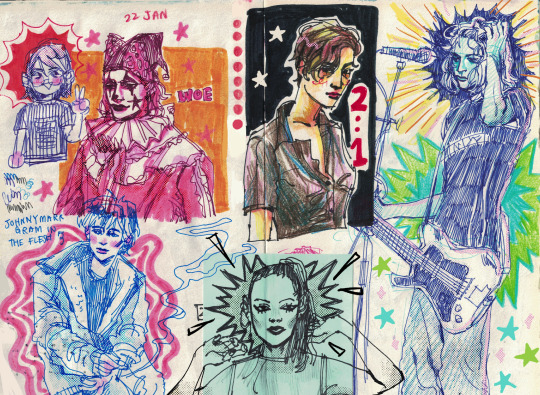

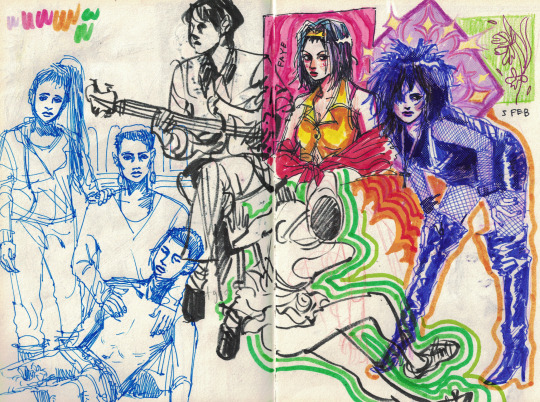
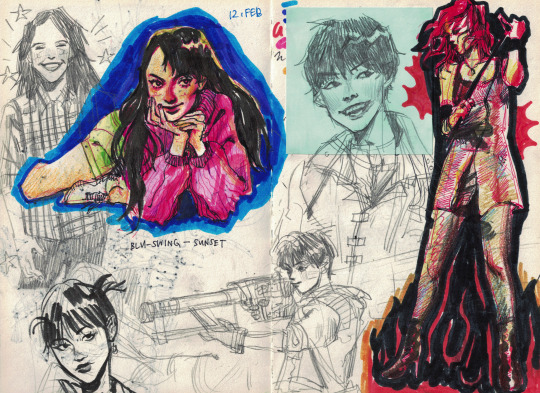
#some good ol sketchbook spreads#johnny marr#the smiths#elastica#justine frischmann#shirley manson#garbage#the garden#pj harvey#art#my art#siouxsie sioux#faye valentine#cowboy bebop#kim deal#the breeders#pixies#kaneda#akira 1988#kurt cobain#nirvana
710 notes
·
View notes
Photo

Shirley Kaneda at Galerie Richard
5 notes
·
View notes
Audio
spoken word
#felicia atkinson#2019#Shelter Press#The Flower And The Vessel#You Have To Have Eyes#French poet#Félicia Atkinson#Type Foundry Studio#Adam Selzer#monolog#monologue#Shirley Jaffe#Shirley Kaneda#David Antin#electronic#Experimental#drone#spoken word#france
0 notes
Text
Female Abstract Painters and Warped: Painting and the Feminine
Warped: Painting and the Feminine was an all female exhibition in 2001, curated by Maggie Ayliffe, who exhibited alongside Jo Bruton, Vanessa Jackson and Rosa Lee all from the UK and Valerie Jaudon, Shirley Kaneda and Joanne Greenbaum from the US. All are contemporary abstract painters who have worked from the 1980’s to the present day. The exhibition was on view in Angel Row Gallery, Nottingham, Middlesbrough Art Gallery and Rugby Art Gallery and Museum. All seven artists are working within pattern and ornament as their painting field and despite coming from different places and leading very different lives they have found a resonance, connecting each other's work and allowing them to form this exhibition. Whilst in virtual conversation with Maggie Ayliffe, Jaudon considered what the most exciting part of this exhibition was and what it meant to her “seven women artists from different backgrounds, countries, ages and education independently sharing “the will to unsettle and perturb” the tightly bound conventions of the 20th century abstract painting (and still questioning the warped nature of this situation)” (Valerie Jaudon, 2001) Warped started out as discussions between these seven artists, and resulted in a contemporary abstract painting exhibition, celebrating the feminine and the progression to break the traditions and beliefs of abstract painting in the 20th century. From this opportunity Jaudon wanted to make a few things clear, things that have often been overshadowed by Modernist abstraction, in particular, the feminine, “what exactly is the connection between abstract painting and the feminine?” (Valerie Jaudon, 2001) In this exhibition the artists have explored femininity in contemporary abstract painting, addressing the term “decorative” and coming to the realisation of how it has formed the basis of “otherness” within Modernist abstraction. “As a pejorative term, the word “decorative” has come to refer to the superfluous, the decadent, diluted, derivative. And yet without these - and I am thinking of those humble arts, known sometimes as crafts” ( Rosa Lee, 2001) To many, the word crafts can appear quite insulting, especially when used in the context of referring to the feminine, evoking the connection with feminine arts being seen as a hobby. This exhibition highlights how abstraction in the form of decoration and pattern is no less a form of abstraction than the likes of action painting, just because it addresses the feminine within the paintings.
https://issuu.com/absolutelyk/docs/warped_brochure_all
0 notes
Text
Félicia Atkinson: The Flower and the Vessel
On Félicia Atkinson’s 2017 solo album Hand to Hand, she said, “I wanted to make sounds like cacti, with water and secrets inside.” She succeeded: Pairing almost unnervingly intimate whispers with heavily abstracted synthetic tones, the album guarded a vivid interior life beneath its prickly exterior.
But as Atkinson began recording the music that would become The Flower and the Vessel, her perception of the relationship between inner and outer realms began to shift. She was pregnant at the time, and she found herself feeling estranged twice over, caught between her surroundings and the new life growing inside her. In hotel rooms at night, as she composed on her laptop and murmured voice memos into her phone, she asked, “What am I doing here? How can I connect myself to the world?”
The Flower and the Vessel is Atkinson’s answer to that question. It is, she says, “a record not about being pregnant but a record made with pregnancy.” The music carries within it the idea of form coming into being; it moves away from the freeform drift of her previous albums and glides toward a nascent kind of order.
Though the album uses sumptuous sounds like a Fender Rhodes, marimba, and vibraphone, its essence remains pensive and sometimes unsettling. Many of the record’s hushed, interwoven elements guard their identities. Contrasting rhythms form a lattice of complementary pulses: On the ominous centerpiece “You Have to Have Eyes,” a deep boat-engine throb mixes in with rapid-fire insect oscillations, creaking doors, and a voice looped like lapping waves. “You had to have eyes in the back of your head,” she murmurs, her voice turned strange and glassy by digital distortion.
As always, there are Atkinson’s uncomfortably close whispers—lips practically brushing the mic, the grain of her voice rendered in molecular detail. She slips between English and French, and though the meaning of her words is not always apparent, the tone of her voice lends a dead-of-night intensity that renders the music’s pockets of silence all the more potent. It is as though you were locked in urgent conversation with her, or even eavesdropping on her very thoughts. But the invasive nature of the tactic—“Whispering is a way to get inside your ear,” she has said—puts an ominous, alienating spin on what we normally think of as an intimate sound.
With many of her texts repurposed from found sources, the precise meaning of most of these songs remains hidden. In “Shirley to Shirley,” she reads excerpts from a conversation between the artists Shirley Kaneda and Shirley Jaffe in Bomb Magazine in an electronically processed voice. In “Un Ovale Vert,” she reads a portion of one of David Antin’s improvised “talk poems” and then, in French, intones images from her own visual art (“a white ball, a green oval”). She is fascinated by the way ideas pass from medium to medium; the methodical way she arranges her sounds is almost painterly. (She also cites ikebana, the Japanese art of flower arrangement, as an influence on the album’s careful sense of balance and proportion.)
The album closes with “Des Pierres,” an 18-minute collaboration with Stephen O’Malley, of Sunn O))), which threads Atkinson’s whispers through nebulous clouds of milky drones and guitar feedback. She calls it an “open reading” of a history of images in stone—that is, the accidental “landscapes” found in gems and geodes—written by the French literary critic Roger Caillois. It’s a characteristically erudite reference, but its presence can be traced throughout the music: the guitars roiling like cloudy agate or glistening like an expanse of obsidian. Again, Atkinson returns to the idea of inside (the crystalline image revealed in a cross-section) versus outside (the rock’s nubby exterior). In the album’s opening track, she whispers a poem to her unborn child, meditating on the way that her voice travels through her body to her baby’s ears, and here, at the album’s end, she plunges us deep into that amniotic world.
~
by Philip Sherburne · July 9, 2019
0 notes
Text
2 coats of paint - The issues facing painting in 2020, Panel discussion
SB: I’ve seen a return to traditional skills and the meditative practice of making the work as a way of enduring. It’s not necessarily political, and I wouldn’t say that it’s decorative, but it has something to do with making it through difficult times.
KB: And I also want to remember a time when Provisional painting was all the rage. We were introduced to James Sienna’s work and were fascinated because here was an abstract painter that had a system. One line crosses over and then goes down. One line crosses over and then goes down. And it looked great. It looked like maybe he was using chance, but he wasn’t. And we were spellbound by that.
JS: It strikes me that these questions of how I’m doing what I’m doing are just as important as what it is I’m painting in that studio. It’s the process versus result.
SB: I agree. I don’t think there’s a painter in this room that doesn’t use both. I don’t think it’s binary–are you using chance or are you being intentional? It’s a spectrum. In the intentional, there’s an element of chance, and in chance, there’s an element of intention. And it’s just a matter of where it is on the scale. That’s the beauty of painting. When you’re working digitally, your head has to be in the process. You’re using fast tools that do what you expect them to do, but when you’re painting, the process is much more meditative. You have the time to notice the accidental and make the decisions that you’re talking about. Those choices comprise the process of painting–yes, no, this, not that. These are the choices that create the meaning. Particularly in abstract painting. How the line is drawn.
TM: That’s an interesting distinction you just brought between digital and manual work because with digital there are so many safeguards from really screwing it up, and with painting you can never escape that.
SB: There is no Command-Z.
TM: In terms of chance versus deliberation, I agree with Sharon, in this room there’s combinations of everything in varying degrees. But even in a painting like Shirley Kaneda’s, it looks like it’s planned out, but look at the brushstrokes and the way that the yellow shapes and the purple shapes overlap the green verticals, and you see a dark U just below the outline of the purple shape, and this space recedes beyond that, and I don’t know whether that was planned or not, but that really works.
Great interview, seemingly what I am going through at the moment. It highlights the thinking of abstract artists today. Seemingly, If my work is going to be process based, how much of it is planned? It’s good to question process vs result. It’s also interesting to think of abstract painting with a system, and how you respond to the decisions you’re making.
The element of ‘primal’ painting at my current stage seems to fall short, and I think yes, using digital is a safe guard. But then it becomes a challenge of process once the safe guard is down, How am I going to interpret it.
0 notes
Photo

Shirley Kaneda
Untiled, 2011
Ink and gouache on paper
22 × 15 in (55.9 × 38.1 cm)
Courtesy the artist
52 notes
·
View notes

